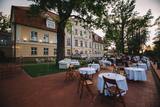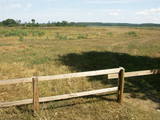| Нo | Название | Описание |
|---|---|---|
|
Находится на северо-восточном берегу Малого Субатского озера. Храм построен в 1685 – 1686 гг. в византийском стиле по распоряжению владельца господской усадьбы «Проде» Х. Ф. Остена - Закена. Это единственная церковь Латвии, архитектура которой напоминает характерные для конца 17 века идеальные формы храмов протестантов. Интерес представляют размещенные в углах здания маленькие башенки. Внутри храма находится богато орнаментированный и украшенный резьбой по дереву скульптурный ансамбль, в т.ч. - алтарь 17 века, кафедра и исповедальня, а также художественные работы 17 - 18 веков и отлитый в 1682 году колокол. Следует упомянуть, что часть церковного интерьера создали ремесленники Стелмужской школы скульпторов по дереву. |
||
|
Divarpus kilometrus gara taka (vienā virzienā) aizved līdz Hallistes palieņu pļavām, kur Hallistes upes labajā krastā ir uzcelts divstāvīgs koka skatu tornis. No tā paveras visaptverošs skats uz atjaunotajām (izcirsti krūmi) Hallistes palieņu pļavām. Pavasara palu laikā no torņa redzamā apkārtne un tornis atrodas ūdenī. |
||
|
Aktīvā atpūta svaigā gaisā, dabā. Dabas taka, atpūtas vieta, grilla vietas, lapenes. Lāzera cīņas jeb Laser tag ir spēle svaigā gaisā, ģimenes vai draugu kompānijā. Iegūsiet pozitīvas emocijas un kārtīgu adrenalīna devu, spēlējot augsti tehnoloģisko spēli reālā laikā un vietā. Lāzera cīņas ir visiem labi zināmā peintbola analogs, bet atšķirīgs ar to, ka Laser taga spēlē spēlētājus-pretiniekus “neitralizē” ar drošiem un nekaitīgiem lāzera šāvieniem no lāzera-ieroča, bet pati spēlētāja “neitralizācija” notiek, kad speciāli devēji (sensori), kuri ir nostiprināti uz spēlētāja apsaites, reģistrē pretinieka lāzera-ieroča staru, kas nozīmē, ka nav ne krāsu bumbiņu, ne sāpīgi sitieni, ne zilumi. Šī koncepcija padara Laser tagu pieejamu ne tikai vīriešiem, bet arī sievietēm un bērniem. |
||
|
Taarka Tarõ Köögikõnõ находится на традиционном крестьянском хуторе сету, и помимо традиционных блюд здесь также предлагаются блюда других финно-угорских народов и блюда украинской кухни. |
||
|
Находится в центре Гайгалавы, в здании административного центра бывшего колхоза. В приготовлении блюд используют продукты, выращенные в своем или соседних хозяйствах. Латышская кухня: Фасолевый суп с перловой крупой, суп из кислой капусты, гороховый суп, суп из листьев столовой свеклы, щавелевый суп, рыбный суп из линя или карпа, жареные ребрышки, жаркое, фальшивый заяц, запеченный в печи карп, вяленая рыба, кисель с творожный кремом, запеченные яблоки с ванильным соусом, рулеты-плетёнки, копченые фрукты и цукаты из цидонии. Особое блюдо: Фасолевые блины. |
||
|
This was the first national park in Lithuania, and it is in the northern part of the Aukštaitija Higland, where hillocks interweave with lots of little lakes and ethnographic villages. Many of the lakes are connected with streams, forming long chains of lakes that are perfect for water tourists.
|
||
|
Один из крупнейших замков Курземе, сохранившийся до наших дней в сравнительно хорошем состоянии. В середине XIII века Рижский домский капитул приступил к строительству замка.В 1434 году Дундагское поместье купил епископ Курляндии. В период с XVI –XX вв. здесь хозяйничали представители рода Майделов и Остен-Сакен.Дундагский замок дважды сгорал и многократно перестраивался. Последний раз замок перестраивался после сожжения в 1905 году. Интерес представляют две стелы из песчаника по обе стороны входных дверей с фигурными рельефами рыцаря (с левой стороны) и епископа (с правой стороны). Замок известен легендами о свадьбе гномов и Зеленой деве. Сегодня в замке находится Дундагская музыкальная и художественная школа, гостиница и зал для торжеств, Дундагский ТИЦ и представлены разные экспозиции. Осмотр замка рекомендуется в сопровождении местного гида. Замок окружает парк, истоки которого относятся к XVII веку. Через парк течет речушка Паце, запруда на которой образует Дундагский пруд. С искусственного острова в пруду видно городище Калнадарзс. В парке по-прежнему зеленеет (некоторые большие ветки обломались) так называемый «Рублёвый дуб», изображение которого находилось на выпущенном в 1919 году денежном знаке – латвийские сто рублей. |
||
|
Хозяйка печет на заказ различные торты, пироги, скландрауши и пирожки с разными начинками. Можно заказать также копченую рыбу. |
||
|
Городище Спринги pасположено недалеко от города Резекне и
вызывает интерес своеобразной формой. Археологический
памятник местного значения.
|
||
|
Ресторан расположен в восстановленном в 2008 году здании Малпилского поместья, которое является памятником архитектуры классицизма XIX века. Меню ресторана меняется и пополняется в соответствии со временем года. Композиция тонких вкусов в сочетании с элегантным интерьером поместья. Латышская кухня: Малпилсский сыр, грибной суп, дичь, жареный судак, десерт из черного хлеба. Особое блюдо: Мороженое Малпилсской усадьбы. |
||
|
Находится на берегу Алуксненского озера, на территории Сельского центра туризма и отдыха «Яунсетас». В построенной корчме-срубе интерьер выполнен в стиле XVII века, когда в Алуксне родилась и под присмотром приемного отца Эрнста Глика выросла будущая императрица России и жена Петра I Екатерина I. Латышская кухня: Суп из рыбы Алуксненского озера (судак или щука), свиной язык, жареное яйцо в панировке из муки, слойка из черного хлеба с брусничным варением и взбитыми сливками. Особое блюдо: Обед во вкусе провинциалов - бульон с профитролями. |
||
|
В северной части парка Засас находится построенная в 1750 году небольшая Засасская лютеранская церковь. В наши дни восстановлен церковный орган, являющийся работой знаменитого органного мастера Андрея Сунакслиса. Рядом с церковью находится кладбище немецких солдат, павших в Первой мировой войне. |
||
|
В Риге насладитесь прогулкой по Старому городу с его узкими мощеными улицами, районом Югендстиля, посетите Центральный рынок, чтобы ощутить местную атмосферу. На пути из Риги посетите Национальный парк Кемери, славящийся своими серными источниками. Пройдитесь по Кемерской болотной тропе. Отдохните в центре отдыха на озере Валгумс - Босоногая тропа, Лабиринт, купание в озере, спа-процедуры и отличный ресторан. Затем маршрут ведет в Музей Шоколада Пуре и сворачивает к древней долине реки Абава, где с 16 века выращивают виноград. Здесь находится малая часть исторического Винного холма, но есть и новые сады и виноградники, которые в последние годы сильно развились. Посетите Педвале – художественное пространство под открытым небом, а затем и живописную Кулдигу с ее хорошо сохранившимся деревянным зодчеством. В деревенском доме в Скрунде посмотрите, как выращивают грибы шитаки и отведайте блюда, из них приготовленные. Лиепая – энергичный город с его внушительным военным наследием, которое сейчас доступно каждому, красивым пляжем из белого песка. Здесь можно отведать особое блюдо – лиепайскую треску. Затем вас ждет визит на козью ферму и дегустация их продукции. Пройдитесь по крутым берегам Юркалне. Откройте для себя Вентспилс с его многочисленными парками, замком Ливонского Ордена, променадом, молом и хорошо оборудованным пляжем. Маршрут идет до места, где Рижский Залив встречается с открытым морем – на мыс Колка, а затем вдоль побережья к Риге. На пути посетите рыбаков в Энгуре. Понаблюдайте за процессом копчения рыбы и попробуйте ее на вкус. Посетите исторический морской и спа курорт Юрмалу с ее красивыми виллами 19 века, пообедайте в местном ресторане, специализирующемся на блюдах из картофеля. |
||
|
Eine Floßhauptstadt Lettlands mit dem jährlichen Flößerfest im Mai. |
||
|
One of the biggest castle hills in Estonia, which is surrounded by walls built of stone. It is mentioned in Livonian Chronicle of Henry as one of the best fortifications at that time. |
||
|
Periodically flooded flood-land meadows on the eastern and southern shores of Lake Burtnieks are an important nesting location for the rarely seen corncrake. A nature and information trail has been established at Vīsrags with directions, information stands and a viewing tower.
|
||
|
The café is in the centre of Ludza, offering a large menu and complex lunches. A speciality of the house is freshwater fish from lakes in Latgale. Latvian cuisine: Pike, tench, carp and pike-perch dishes, with blood sausage, other sausages and pig’s snout prepared on order for the Winter Solstice. Special foods: Cold appetizer of ground fish with ingredients |
||
|
The most important aspects of this park are a shallow lagoon-type lake – Lake Pape, with its flood land meadows, the shore of the Baltic Sea, the Nida swamp, and the more than 270 different types of birds that have been spotted here. The oldest bird ringing station in Latvia (est. 1966) is found between Lake Pape and the Baltic Sea. Birds and bats are caught and ringed there. Lake Pape is the first place in Latvia where so-called “wild” horses (the “Konik” breed) were released with the aim of managing the flood land meadows.
|
||
|
The Liv Coastline involves a series of shoreline villages from Ovīši to Ģipka along the shores of the Baltic Sea and the Bay of Rīga. Like Latvians, Livs are an indigenous population in Latvia, with ancestors who lived here at least 5,000 years ago. They populated extensive parts of Kurzeme and Vidzeme, and the area in which they lived the longest was Northern Kurzeme, on the shores of the Baltic Sea. Today visitors to the Liv Coastline mill meet real Liv fishermen, feel the aroma of smoked fish, enjoy traditional dishes, look at diverse ancient fences, learn about the reticent charm of the local landscape, enjoy the place where two seas, birds and people meet at Cape Kolka, hear the Liv dialect of the Latvian language, see rounded hillocks and swampy areas, visit the Šlītere lighthouse, and see the green-white-blue Liv flag, red bilberries, bird migration routes and blue cows. The oldest evidence of the life of Livs can be found in the Liv centres. The Liv language and culture are still alive in place names, handicrafts, folk costumes, and the world view and lifestyle of people who live in the area. The Liv language and cultural values are part of Latvia's national cultural heritage, and traditional Liv culture is part of the Latvian Canon of Culture. |
||
|
Guided wilderness experience day-trip combines bog shoeing and canoeing. First is walking through the forest and reaching the largest peat-bog in Estonia – Kuresoo. Wear bogshoes and walk on the wild landscape, followed by wilderness lunch. The trip ends with a relaxing canoe trip along Soomaa meandering rivers. |
||

















